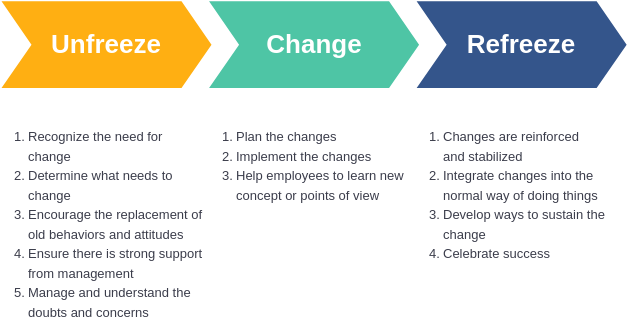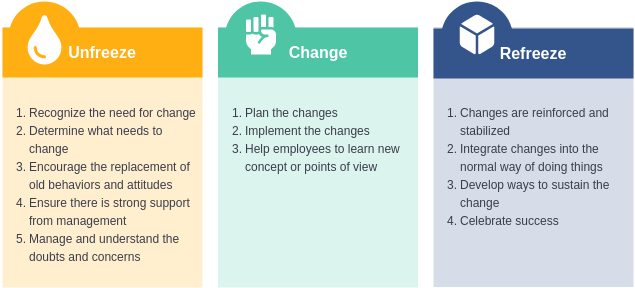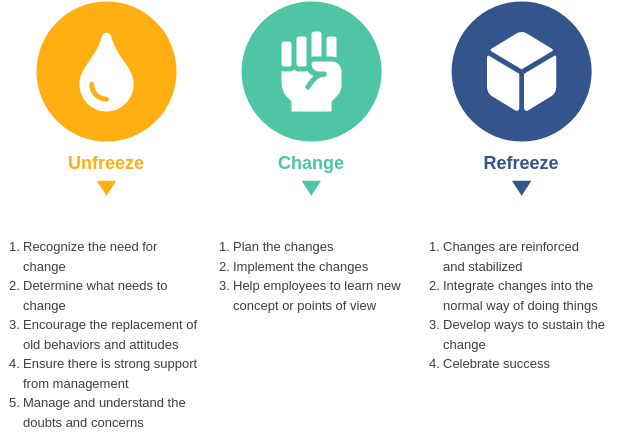What is Lewin’s Change Management Model? With Templates, Examples and Free Tool
Lewin’s Change Management Model is a comprehensive change model designed to understand why change happens and what must be done to effect change in the most seamless way. Lewin developed the change model as a way to illustrate how people react when faced with change in their lives. Lewin’s change management model can be applied in a wide range of contexts. For example, it can help you understand why some people and organizations are motivated more by the need for social recognition than by financial incentives, and it teaches you how to engage employees in important organizational change.
The three stages of Lewin’s Change Management Model
The three stages of the process include unfreezing (the person has an existing state), changing to a new way of being, and then completely refreezing to a new state!
- Unfreezing – The first stage of the process involves someone being ready and willing to make all the changes needed. This state is called unfreezing. For example, it could involve anything from identifying the problem to getting permission to act.
- Change – In the second stage, people actually make the change. This means moving or changing, which is usually not easy! People face many different challenges, ranging from being uncomfortable to feeling unsure about making a change. People may also feel as if they have lost something important by giving up the old ways, and this is where they may encounter resistance.
- Refreezing – In the final stage, people are finally able to refreeze into a new state. At this point, they accept their change and feel that all the energy they have put into it was worth it.

If all three stages are successfully completed, the change management process can be considered a success! The team may also feel more comfortable than ever before with what is happening in their lives right now. When employees make positive changes in their work, they begin to feel motivated and engaged!
But to understand it better, let’s take a deeper look into each of the steps of the Lewin Change Model.
Stage 1 – Unfreeze
The first step in change is to prepare the organization to accept that change is necessary, whether it is financial, managerial or organizational. This is a necessary step that can be achieved by first recognizing the need for change and then creating a sense of change among employees. The key here is to create a compelling narrative that explains why the current way of doing things cannot continue.
For example, this is easier to convey when you can point to declining sales figures, poor financial results, negative customer satisfaction surveys, or other similar data.
To properly prepare your organization, you must start with its foundation – you must question the philosophy, values, attitudes and behaviors that define your company. Using the building analogy, you must evaluate and be prepared to modify existing foundations, as they may not be able to support additional floors. If you don’t, the entire structure may collapse.
This is often the most challenging and stressful aspect of the change process. When you start changing “the way things are done,” you throw everyone and everything out of balance. You may provoke a strong reaction from people, and that’s exactly what needs to be done. By pushing your company to re-examine its core values, you can effectively create a (managed) crisis, which can provide a powerful incentive to find a new balance. Without that momentum, you won’t have the support and engagement you need to make real change.
When you start changing “the way things are done,” you throw everyone and everything out of balance. You may provoke a strong reaction from people, and that’s exactly what needs to be done. By pushing your company to revisit its core values, you can effectively create a (managed) crisis, which can provide a powerful impetus for finding a new balance. Without that momentum, you won’t have the support and engagement you need to make real change.
Stage 2 – Change
Once the organization is ready to act, you must begin to act on your ideas. You need to eliminate any current resistance by focusing on short-term wins and a clear communication strategy. When people feel uncertain about change, they tend to make choices based on their fears rather than the expected benefits or rewards.
In order to gain support and momentum, you must be able to demonstrate that your idea has real value to the organization. You will usually do this by showing how it will improve productivity or financial performance in some way. To gain further support, use “selling” tactics with key influencers rather than trying to convince everyone right away. If you succeed in attracting the right people, they will help promote your idea and attract others to join.
It’s also important to celebrate milestones and wins in the process, which will reinforce people’s belief that they are making progress while feeling good about themselves overall. This should be done as openly as possible in order to generate more momentum among those who are not yet convinced.
Stage 3 – Refreeze
The final stage of the Lewin Change Model is the refreeze, where the organization moves from change to “business as usual” (the new status quo). This means that everyone has accepted the changes and is committed to sustaining them.
The best way to do this is with an “integration” strategy, where you can take time to review your accomplishments to date, celebrate successes, and resolve any outstanding issues that may arise along the way. If all goes well, your organization is now stronger than ever and better equipped to meet the challenges of the future.
If you were unsuccessful in one or both of the previous phases, it is critical to take a step back, conduct a self-assessment, and understand what went wrong in order to make the necessary adjustments for the next time. This will allow your organization to learn from mistakes rather than repeat them.
How can you strengthen preventive measures so that you can better implement change next time?
The Best Infographic Tool
Visual Paradigm Online (VP Online), an online Lewins Change Model drawing editor, supports Lewins Change Model and other diagram types such as SWOT Analysis, 6 Thinking Hats, 5S Model, ERD, Organizational Charts, etc. With the intuitive Lewins change model editor, you can plot Lewins change models in seconds.
Explore more Lewin’s Change Model templates
Unfreeze Change Refreeze Model
Lewin Model of Change
Lewin’s 3-Stage Model
Lewin Change Model
Lewin Change Model Template
Lewin Change Management Model
Lewin’s 3-Stage Change Model
Lewin’s Change Model Template
Lewin’s Change Model








